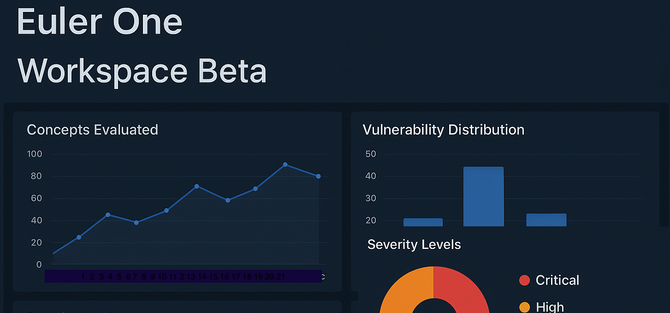Provable security for Gen AI applications based on mathematical foundations
Revolutionary technology to protect AI models from malicious exploitation, weak safety & security guardrails, and backdoors

Euler One puts AI Security Controls in your hands
Euler One enables organizations to identify and block unwanted malicious capabilities in their AI model....with math-proof guarantees....allowing them to unlock the powers of AI in their business without the issues
Detect vulnerabilities in your deployed AI model. Identify weak safety and security guardrails
The safety and security guardrails installed in AI models by providers can be bypassed by attackers, leading to harm to users. Euler One provides organizations the ability to interrogate the protection guarantees in their model against unwanted capabilities, e.g., can my model output my sensitive private data ? With Euler One, customers can identify these vulnerabilities in their environment, enabling risk-informed corrective actions.
Block unwanted malicious capabilities in your AI model. Fortify your AI against future attacks
Euler One enables organization to block unwanted capabilities in their AI, with math-proof guarantees. E.g., an analyst, whose AI ingest email from clients and output code is concerned the AI can be manipulated (via prompt injection) to output malware. If the model has this capability, even benign, Euler One can block it in the model itself. This is driven by Euler One's revolutionary technique to nullify arbitrary concepts in LLMs using abstract mathematical signatures.
Tailored to your unique business need. Keeps you compliant amidst evolving AI regulatory standards
Securing AI should not be one-size-fits-all since every user has a unique AI business use case. Euler One enables your business needs to dictate how AI is constrained in your environment. As new AI threats rise, authorities will pass new industry-specific regulations, e.g., health care AI must not output private patient data, per HIPAA laws. Euler One ensures this via dynamic templates for new and existing regulations unique to specific industries, allowing you unlock AI productivity without the worries.
Driven by a mission to democratize AI safety for all, making it more attainable, especially to the most vulnerable
Medium to small-size enterprises, ordinary users, .. are most vulnerable to rising AI threats, as many rush to AI without needed protections.
As AI become widely adopted and Large Language Models (LLMs) become ubiquitous, attackers gain new attack surface with the added super powers of AI to cause harm on an exponential level. Worse, AI threat understanding are changing and rising very fast, and regulatory authorities are scrambling to map out the threat landscape in order to release effective safety standards. While big organizations can afford costly high-end AI firewalls and routine red-teaming services, smaller enterprises are left to the exploit of attackers
Euler One levels the playing field of AI security and safety
Attackers can fool AI.
But, they cannot fool Math!
Euler One is based on a novel technology that derives abstract mathematical signatures to detect and localize arbitrary concepts in LLMs

As organizations race to adopt AI to increase productivity and profits, attackers gain a wider opportunity and increased capability to cause harm, putting them on an asymmetrical advantage against defenders

As new AI security regulations and AI safety standards continue to change and evolve, current firewall-based AI defenses will not scale
Recent work show that current guardrails in AI models can be circumvented, making LLMs are vulnerable to exploitation. Current solutions offer "work-around" mitigations (e.g., prompt filtering) via firewalls, rather than tackle the underlying hard problem. Still, advanced attacks such as backdoors have no known defense. Worst, every AI new security regulation will constitute another entry on an AI firewall. As such, this security model may not scale well.
Euler One is based on understanding the underlying mathematical foundations of LLMs to develop novel techniques to secure AI models at their root.
Current AI Adoption and Risk
78%
or organization reported using AI in 2024, a 55% incease from previous year - Stanford HAI 2025
83%
of companies consider AI a top priority in their current and future business plans - Exploding topics 2025
$279 B
the The global AI market size in 2024, and projected to reach $1.8 trillion in 2023 - Grand View Reseach
600+
AI related bills, with 99 enacted into law. UK announced E100 million commitment to establish AI Safety Institute
Growing Number of Laws and Regulations
- In 2024, U.S. state lawmakers introduced over 600 AI-related bills
- 99 of them enacted into law, a significant jump from 2023
- fewer than 200 such bills were introduced in 2023
- U.S. federal agencies introduced 59 AI-related regulations in 2024
- This is more than double the number from 2023.
- Globally, legislative mentions of AI have risen 21.3% across 75 countries since 2023

